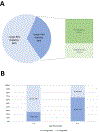Analysis of lumbar spine stenosis specimens for identification of amyloid
- PMID: 35929177
- PMCID: PMC9771886
- DOI: 10.1111/jgs.17976
Analysis of lumbar spine stenosis specimens for identification of amyloid
Abstract
Background: Lumbar spinal stenosis (LSS) is a common reason for spine surgery in which ligamentum flavum is resected. Transthyretin (TTR) amyloid is an often unrecognized and potentially modifiable mechanism for LSS that can also cause TTR cardiac amyloidosis. Accordingly, older adult patients undergoing lumbar spine (LS) surgery were evaluated for amyloid and if present, the precursor protein, as well as comprehensive characterization of the clinical phenotype.
Methods: A prospective, cohort study in 2 academic medical centers enrolled 47 subjects (age 69 ± 7 years, 53% male) undergoing clinically indicated LS decompression. The presence of amyloid was evaluated by Congo Red staining and in those with amyloid, precursor protein was determined by laser capture microdissection coupled to mass spectrometry (LCM-MS). The phenotype was assessed by disease-specific questionnaires (Swiss Spinal Stenosis Questionnaire and Kansas City Cardiomyopathy Questionnaire) and the 36-question short-form health survey, as well as biochemical measures (TTR, retinol-binding protein, and TTR stability). Cardiac testing included technetium-99m-pyrophosphate scintigraphy, electrocardiograms, echocardiograms, and cardiac biomarkers as well as measures of functional capacity.
Results: Amyloid was detected in 16 samples (34% of participants) and was more common in those aged ≥ 75 years of age (66.7%) compared with those <75 years (22.3%, p < 0.05). LCM-MS demonstrated TTR as the precursor protein in 62.5% of participants with amyloid while 37.5% had an indeterminant type of amyloid. Demographic, clinical, quality-of-life measures, electrocardiographic, echocardiographic, and biochemical measures did not differ between those with and without amyloid. Among those with TTR amyloid (n = 10), one subject had cardiac involvement by scintigraphy.
Conclusions: Amyloid is detected in more than a third of older adults undergoing LSS. Amyloid is more common with advancing age and is particularly common in those >75 years old. No demographic, clinical, biochemical, or cardiac parameter distinguished those with and without amyloid. In more than half of subjects with LS amyloid, the precursor protein was TTR indicating the importance of pathological assessment.
Keywords: amyloidosis; cardiac; lumbar spinal stenosis; transthyretin.
© 2022 The American Geriatrics Society.
Figures


Comment in
-
Analysis of lumbar spine stenosis for identification of amyloid.J Am Geriatr Soc. 2022 Dec;70(12):3356-3358. doi: 10.1111/jgs.18092. Epub 2022 Nov 12. J Am Geriatr Soc. 2022. PMID: 36370426 No abstract available.
References
-
- Yanagisawa A, Ueda M, Sueyoshi T, et al. Amyloid deposits derived from transthyretin in the ligamentum flavum as related to lumbar spinal canal stenosis. Mod Pathol. 2015;28: 201–207. - PubMed
-
- Godara A, Riesenburger RI, Zhang DX, et al. Association between spinal stenosis and wild-type ATTR amyloidosis. Amyloid. 2021;28: 226–233. - PubMed
Publication types
MeSH terms
Substances
Grants and funding
LinkOut - more resources
Full Text Sources
Medical
Research Materials
Miscellaneous

